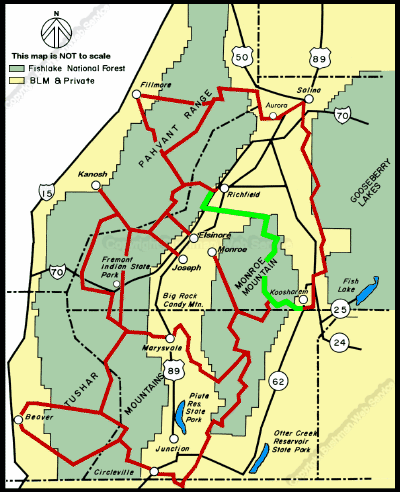|

The ride from Richfield to the junction with the Paiute ATV Trail
near Koosharem Guard Station takes about three hours. Intermediate
times along this loop are as follows:
Approximate Section Time
·Richfield to Annabella -------------------------------------
0.75 hr
·Annabella to junction with road 68 ----------------------
0.25 hr
·Junction of road 68 to Big Lake -------------------------
0.75 hr
·Big Lake to Magleby Pass -------------------------------
0.5 hr
·Magleby Pass to Koosharem Guard Station
the junction with the main trail ------------------------ 0.75
hr
From the 5,400 foot elevation of Richfield, this loop rises gently
along the canal before descending to 5,255 feet at the Sevier River
crossing. Then there is a gentle rise to 5,300 feet at Annabella
and then 5,995 feet at the junction with Forest Road 68. From this
junction the trail rises rapidly to 7,400 feet on Bell Rock Ridge.
From there it is a gradual assent to 9,320 feet at Big Lake, and
on to the 10,488 foot elevation at Magleby Pass, the high point
of this loop. The trail then descends to 9,070 feet at the junction
with the main Paiute trail.

The western leg of the Richfield loop is described on page 6
as the first segment of the Richfield to Fremont Indian State Park
leg.
The eastern leg of this loop also starts on the west edge of
Richfield at the information kiosk. Immediately west of the Interstate
70 bridge the eastern leg turns left at the first road and heads
south along the west side of I-70. About a mile south of the turn,
the trail crosses over a box culvert that carries the Sevier Valley
Canal under the interstate highway. From there on south to the underpass
the trail is along the canal bank road which is fairly rough. Those
traveling north along this loop towards Richfield should note that
you do not leave the side of the canal until you cross the box culvert.
The canal-bank road passes between two arteries of transportation.
On the east side is I-70 carrying vehicular traffic, while on the
west is the canal carrying the lifeblood of agriculture, here and
in the west, where most of the precipitation occurs as snow in the
mountains. Thus, watershed protection is one of the main concerns
of the land managing agencies, such as the Bureau of Land Management
and Forest Service.

continued next page

Last changes:
Thursday, December 09, 2010
|